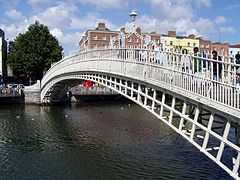Ha'penny Bridge
| Ha'penny Bridge Droichead na Life[1] | |
|---|---|
 Location of the Ha'penny Bridge in Ireland | |
| Other name(s) | Liffey Bridge (official), Wellington Bridge (historical) |
| Carries | Pedestrians[2] |
| Crosses | River Liffey |
| Locale | Dublin |
| Design | Arch bridge[2] |
| Material | Cast iron (arch), wood (deck)[2] |
| Total length | 43 metres (141 ft)[3] with a 3.35 metres (11.0 ft) rise[2] |
| Width | 220 |
| Number of spans | 1 |
| Opened | May 1816 |
| Coordinates | 53°20′46″N 6°15′47″W / 53.3461°N 6.263°WCoordinates: 53°20′46″N 6°15′47″W / 53.3461°N 6.263°W |
The Ha'penny Bridge (Irish: Droichead na Leathphingine, or Droichead na Life), known later for a time as the Penny Ha'penny Bridge, and officially the Liffey Bridge, is a pedestrian bridge built in 1816 over the River Liffey in Dublin, Ireland.[2] Made of cast iron, the bridge was cast at Coalbrookdale in Shropshire, England.[4]
Name

Originally called the Wellington Bridge (after the Duke of Wellington), the name of the bridge changed to Liffey Bridge. The Liffey Bridge (Irish: Droichead na Life)[1] remains the bridge's official name to this day, although it is still commonly referred to as the Ha'penny Bridge.
History
Before the Ha'penny Bridge was built there were seven ferries, operated by a William Walsh, across the Liffey.[2] The ferries were in a bad condition and Walsh was informed that he had to either fix them or build a bridge. Walsh chose the latter option and was granted the right to extract a ha'penny toll from anyone crossing it for 100 years.[citation needed] Initially the toll charge was based, not on the cost of construction, but to match the charges levied by the ferries it replaced. A further condition of construction was that, if the citizens of Dublin found the bridge and toll to be "objectionable" within its first year of operation, it was to be removed at no cost to the city.[3]
The toll was increased for a time to a Penny Ha'penny (one and a half pence), but was eventually dropped in 1919. While the toll was in operation, there were turnstiles at either end of the bridge.
Renovation and maintenance
In 2001 the number of pedestrians using the bridge on a daily basis was 27,000 and, given these traffic levels, a structural survey indicated that renovation was required.[3] The bridge was closed for repair and renovations during 2001 and was reopened in December 2001, sporting its original white colour.[4]
The structure was rebuilt to retain many of its old components, although, controversially, some features were removed. The repair work was carried out by Harland and Wolff.[5]
In 2012, citing a maintenance and damage risk, Dublin City Council removed a number of love locks from the Ha'penny Bridge and nearby Millennium Bridge.[6]
References
- ↑ 1.0 1.1 Official Irish translation by the Placenames Commission
- ↑ 2.0 2.1 2.2 2.3 2.4 2.5 Ha'penny Bridge at Structurae
- ↑ 3.0 3.1 3.2 "Project history of Dublin’s River Liffey bridges" Bridge Engineering 156 Issue BE4, Phillips & Hamilton
- ↑ 4.0 4.1 Archiseek page on the Ha'penny Bridge
- ↑ BBC News - Dublin bridge reopens after 'make-over' - 21 December, 2001
- ↑ "Where’s the love? Council removes ‘love padlocks’ from Dublin’s Ha’penny Bridge". thejournal.ie. 2012-01-13. Retrieved 2012-09-24.
External links
| Wikimedia Commons has media related to Ha'penny Bridge. |
| |||||